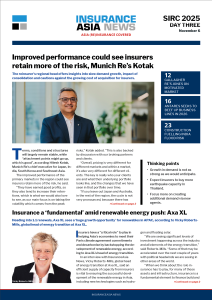SIRC: Long-term fundamentals are strong with this one: APAC prime for ILS growth, Swiss Re says
November 5 2025 by Mithun Varkey
While issuance volumes in APAC are still relatively modest, the long-term fundamentals are strong, according to Andy Palmer, head of ILS structuring for EMEA and APAC at Swiss Re.
“The region’s growing exposure base, coupled with rising insurance penetration and a more supportive regulatory environment, will underpin further development of the ILS market,” Palmer said.
Key considerations for issuers in Asia Pacific include diversification of reinsurance capacity, he added.
“ILS provides an additional, complementary source of protection alongside traditional reinsurance,” Palmer said.
“This also supports a strategic consideration to build, on the one hand, the IP and know-how, and on the other hand, relationships with ILS investors for a sustainable risk transfer framework in the future, and before such additional capacity needs become acute e.g. due to growth or a large nat cat event.”
Innovation and risk management is another consideration, according to Palmer.
“Regional insurers and reinsurers are increasingly viewing ILS as a strategic tool to manage capital efficiently under evolving solvency frameworks,” he added.
Meanwhile, policy initiatives in Singapore and Hong Kong are lowering barriers to entry and simplifying issuance, encouraging local players to explore the market.
“Both jurisdictions have seen strong take-up in recent years and the frameworks have been developed and improved based on live experience,” Palmer said.

“The main limitation holding back cover for more regions and perils is generally the availability of widely accepted models.”
Andy Palmer, Swiss Re
Swiss Re Capital Markets has been active in working directly with both Hong Kong and Singapore in respect of developing their respective ILS jurisdictions to support the growing ILS market in Asia and beyond.
“The ILS market provides important capacity for Asia and the wider APAC region, and we anticipate that it will provide further capacity in future as insurance penetration grows and as risk transfer needs continue to increase,” he added.
Market development going forward will depend as much on increasing risk transfer needs alongside innovation and risk management decisions within evolving solvency frameworks.
Among the challenges, Palmer highlighted the limited availability of high-quality loss data and robust modelling capabilities, as many regions and perils do not have vendor models, which also links to ensuring there is sufficient investor comfort with the risks.
“The main limitation holding back cover for more regions and perils is generally the availability of widely accepted models. These are typically developed for region and perils where there is a sizeable insurance market, so there is usually an alignment between model availability and risk transfer needs,” he said.
As the insurance market develops and risk transfer needs grow, the availability of data helps to provide risk takers with the necessary insights to adequately understand and cost the risk, and therefore underpins the availability of capital.
Future product development
“Even today, there are many clients that could sponsor an indemnity cat bond if it made strategic sense to do so,” according to Palmer.
“In the meantime, we have seen parametric cat bonds successfully structured in the region, and the development of initiatives such as the PERILS Extended Industry Loss Database that provides industry loss estimates across the region can serve to support future product development.”
There are also other elements to consider part from regulatory complexity and cost of issuance relative to program size, Palmer added,
“As ILS products are fully collateralised, there is a minimum return requirement that means that pricing is often greater than that required by a well-diversified reinsurer with a strong balance sheet for risks in the region,” he said.
The investor base for ILS, however, remains predominantly concentrated in the US and Europe.
“As education of ILS as an asset class and its risk-return profile continues to develop, alongside aspects such as regulatory clarity around investment limits and capital treatment, we may see more ILS fund managers being created locally,” he added.
-
Beazley | What does cyber protection look like from day 1 to day 600 and beyond?
Cybersecurity is no longer just an IT concern, but a governance issue that belongs on the boardroom agenda.
-
Sedgwick | Preparing for the next storm
Insurance industry needs to recalibrate, invest in innovation and strengthen systems, talent and data practices.
-
Peak Re | From climate modelling to market opportunity: Forging a new clarity on Southeast Asia’s climate risk
Southeast Asia's protection gap: a crisis of clarity, not just capital
-
BHSI WICare+ | Accelerating Payments, Empowering Recovery
Launched in cooperation with Steadfast’s Singapore network, WICare+ fills the gaps found in traditional coverage and keeps businesses and their workforce secure by covering up to SG$350,000 in medical expenses per claim.

